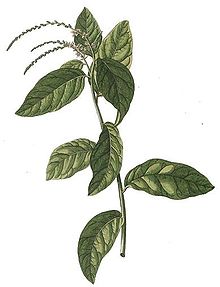- Petiveria alliacea
-
Petiveria alliacea 
Scientific classification Kingdom: Plantae (unranked): Angiosperms (unranked): Eudicots (unranked): Core eudicots Order: Caryophyllales Family: Phytolaccaceae Genus: Petiveria Species: P. alliacea Binomial name Petiveria alliacea
L.[1]Synonyms Mapa graveolens
P. corrientina
P. foetida
P. graveolens
P. hexandria
P. paraguayensisPetiveria alliacea is a species of flowering plant in the pokeweed family, Phytolaccaceae, that is native to Florida and the Lower Rio Grande Valley of Texas in the United States,[2] Mexico, Central America, the Caribbean, and tropical South America.[1] Introduced populations occur in Benin and Nigeria.[3] It is a deeply rooted herbaceous perennial shrub growing up to 1 m (3.3 ft) in height and has small greenish piccate flowers. The roots and leaves have a strong acrid, garlic-like odour which taints the milk and meat of animals that graze on it.
Contents
Common Names
It is known by a wide number of common names including: guinea henweed, anamu in the Dominican Republic, Puerto Rico and Brazil (where it is also known as tipi), apacin in Guatemala, mucura in Peru, and guine in many other parts of Latin America, feuilles ave, herbe aux poules, petevere a odeur ail, and, in Trinidad, as mapurite (pronounced Ma-po-reete) and gully root[4], and many others.
Uses
Medicinal
Petiveria alliacea has been widely used to treat an astounding range of medical conditions both in humans and in animals including: sexually-transmitted diseases, an antiseptic, arthritis, pain, cancer, womb inflammation, diuretic, decoagulant, cold, snake bite, influenza, colds, hysteria, paralysis, fever, rabies, to treat arrow poison in Brazil and as an abortifacient.
Non-medicinal
P. alliacea is used as a bat and insect repellent.
Chemistry
Petiveria alliacea has been found to contain a large number of biologically active chemicals including benzaldehyde, benzoic acid, benzyl-2-hydroxyethyl-trisulphide, coumarin, isoarborinol, isoarborinol acetate, isoarborinol cinnamate, isothiocyanates, polyphenols, senfol, tannins, and trithiolaniacine.[5]
The plant's roots have also been shown to contain cysteine sulfoxide derivatives that are analogous to but different from those found in such plants as garlic and onion. For example, P. alliacea contains S-phenylmethyl-L-cysteine sulfoxides (petiveriins A and B)[6] and S-(2-hydroxyethyl)-L-cysteines (6-hydroxyethiins A and B). These compounds serve as the precursors of several thiosulfinates such as S-(2-hydroxyethyl) 2-hydroxyethane)thiosulfinate, S-(2-hydroxylethyl) phenylmethanethiosulfinate, S-benzyl 2-hydroxyethane)thiosulfinate and S-benzyl phenylmethanethiosulfinate (petivericin).[7] All four of these thiosulfinates have been found to exhibit antimicrobial activity.[8]
References
- ^ a b "Petiveria alliacea L.". Germplasm Resources Information Network. United States Department of Agriculture. 2008-07-28. http://www.ars-grin.gov/cgi-bin/npgs/html/taxon.pl?431298. Retrieved 2010-04-05.
- ^ Mild, Christina (2004-06-26). "Smelly Weed Is Strong Medicine" (PDF). Rio Delta Wild. http://www.riodeltawild.com/JanJune2004/Petiveria%20alliacea.pdf. Retrieved 2010-04-05.
- ^ Schmelzer, G.H.; A. Gurib-Fakim (2008). Medicinal Plants. Plant Resources of Tropical Africa. pp. 412–415. ISBN 9789057822049. http://books.google.com/books?id=7FJqgQ3_tnUC.
- ^ Mendes, John. 1986. Cote ce Cote la: Trinidad & Tobago Dictionary, Arima, Trinidad, p. 95.
- ^ "Petiveria alliacea". Medicinal Plants for Livestock. Cornell University Department of Animal Science. http://www.ansci.cornell.edu/plants/medicinal/anamu.html. Retrieved 2010-04-04.
- ^ Kubec, Roman; Musah, Rabi Ann (2001). "Cysteine sulfoxide derivatives in Petiveria alliacea". Phytochemistry 58: 981–985. http://www.rabimusah.com/pdfs/Cysteine%20Sulfoxide%20Derivatives%20in%20Petiveria%20Alliacea.pdf.
- ^ Kubec, Roman; Kim, Seokwon; Musah, Rabi ann (2002). "S-Substituted cysteine derivatives and thiosulfinate formation in Petiveria alliacea--Part II". Phytochemistry 61: 675–680. http://www.rabimusah.com/pdfs/Cysteine%20S-Substituted%20Cysteine%20Derivatives_part%202.pdf.
- ^ Kim, Seokwon; Kubec, Roman; Musah, Rabi Ann (2006). "Antibacterial and antifungal activity of sulfur-containing compounds from Petiveria alliacea". Journal of Ethnopharmacology 104: 188–192. http://www.rabimusah.com/pdfs/Antibacterial%20and%20Antifungal%20Activity.pdf.
- Johnson, Lisa. 1999. Anamu: Petiveria Alliacea. 14 pages (paperback). Woodland Publishing. ISBN 1-58054-038-4 (In Spanish).
External links
 Media related to Petiveria alliacea at Wikimedia Commons
Media related to Petiveria alliacea at Wikimedia Commons  Data related to Petiveria alliacea at WikispeciesCategories:
Data related to Petiveria alliacea at WikispeciesCategories:- Phytolaccaceae
- Plants described in 1753
- Flora of the Caribbean
- Flora of Central America
- Flora of Florida
- Flora of Mexico
- Flora of the U.S. Rio Grande Valleys
- Flora of South America
- Medicinal plants
Wikimedia Foundation. 2010.
